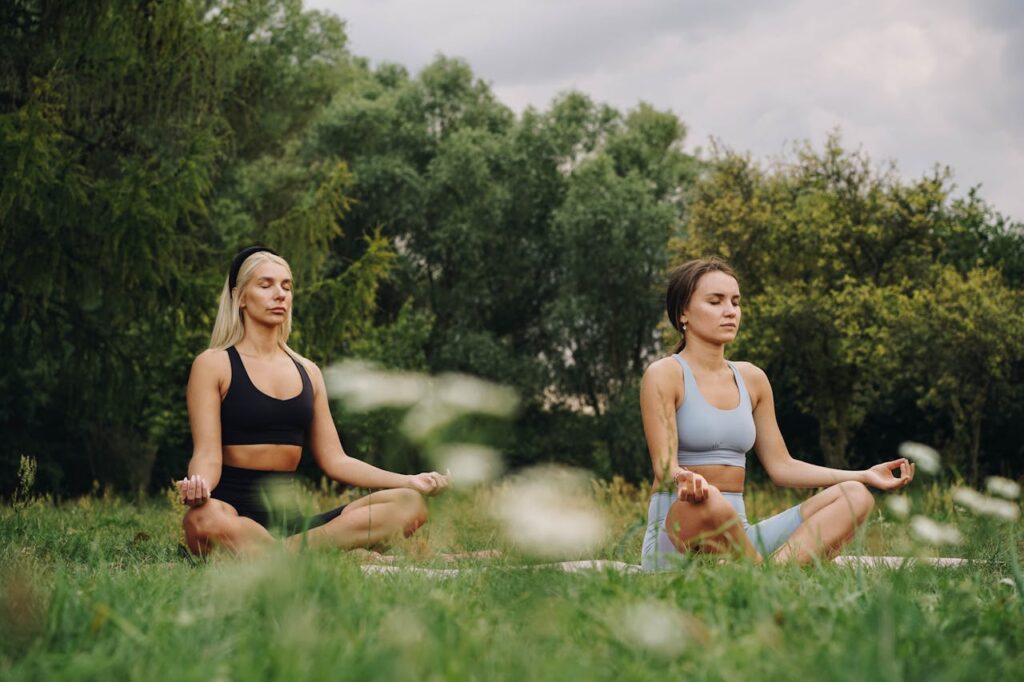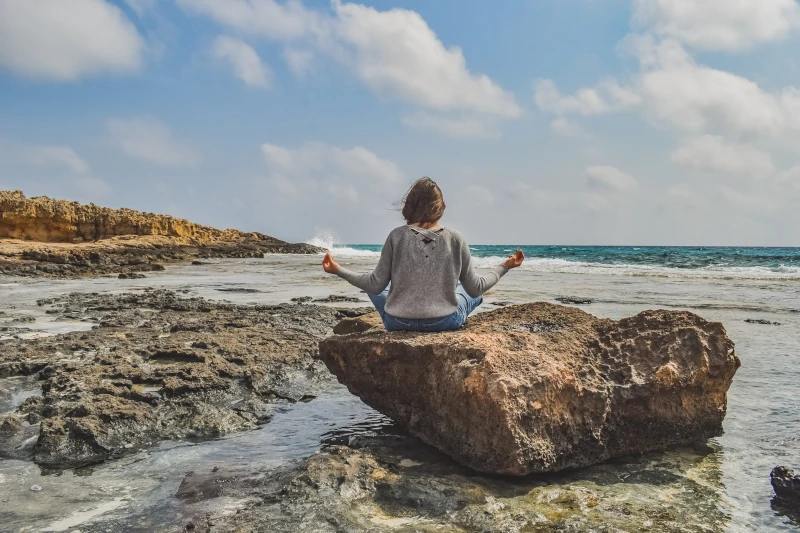Reflect on your meditation journey and the transformative impact on personal growth. Stay motivated and explore resources for continued practice. Your journey in meditation for beginners is just beginning.
Introduction: The Gateway to Inner Peace
Embarking on the path of Meditation opens the door to a world of inner tranquility and mindfulness. However, Meditation for Beginners is much more than a practice of sitting in silence; it’s a journey towards understanding the depths of one’s mind and finding peace amidst the chaos of everyday life.
Understanding Meditation: More Than Just Sitting Quietly
Meditation involves training the mind to achieve a state of concentrated awareness of a thought, object, or process. For beginners, it’s crucial to understand that Meditation is an active process, engaging both the mind and body in pursuit of inner peace and mindfulness. This foundational practice offers a way to enhance mental clarity, emotional calm, and physical relaxation.
The Benefits of Meditation: A Comprehensive Overview
- Improves Mental Health: Regular Meditation can significantly reduce levels of anxiety and depression, fostering a sense of well-being.
- Enhances Concentration: It sharpens the mind, improving concentration and focus, which are invaluable in personal and professional life.
- Boosts Emotional Health: Meditation can lead to an improved self-image and a more positive outlook on life.
- Reduces Stress: One of the most immediate effects of Meditation is stress reduction, which helps to manage stress by affecting the body’s stress response.
- Improves Sleep: By promoting overall relaxation, Meditation can enhance sleep quality. Learn more.
Laying the Foundation
What is Meditation? Demystifying the Practice
Meditation might seem daunting at first, but at its heart, it’s a simple practice. It’s the act of directing one’s focus away from distracting thoughts toward a single point of reference, such as the breath, a mantra, or a particular sensory experience. This practice helps cultivate a higher state of awareness and focused attention.
The History and Evolution of Meditation
Meditation has roots in various cultures and religions worldwide, from Buddhism and Hinduism to Christianity and Islam, each offering a unique perspective. Over the centuries, it has evolved from a spiritual pursuit into a popular relaxation and stress management tool recognized for its profound benefits on the mind and body.
Common Myths and Misconceptions About Meditation
- Myth: Meditation requires emptying the mind of thoughts. Meditation involves noticing thoughts as they arise without judgment and gently guiding the focus to the chosen point of attention.
- Myth: You need to meditate for hours for it to be effective. Even short periods of Meditation can be beneficial, making it an accessible practice for everyone.
- Myth: Meditation is religious. While it has spiritual roots, Meditation is a secular practice beneficial to people of all beliefs and backgrounds.
Preparing for Your Meditation Journey
Embarking on your meditation journey is an exciting step towards achieving inner peace and mindfulness. This chapter will guide you through setting up your meditation space, choosing the right time to meditate, and discussing the essential tools and accessories that enhance your practice.
Creating Your Meditation Space: Setting the Scene for Serenity
Creating a dedicated meditation space is crucial for many beginners in establishing a consistent practice. Your meditation space doesn’t have to be elaborate; it simply needs to be a quiet, comfortable place to relax without interruptions. Here are a few tips:
- Choose a Quiet Corner: Your space should be away from high-traffic areas in your home.
- Make It Comfortable: Include comfortable seating such as a cushion, chair, or meditation bench.
- Personalize Your Space: Add elements that create a serene ambiance, such as candles, a small table for tea, or a plant.
- Keep It Clean: A tidy space helps promote a calm mind.
Choosing the Right Time: When to Meditate for Optimal Results
Finding the right time to meditate is personal and can significantly impact the effectiveness of your practice. Most practitioners find early morning or late evening the most peaceful times. However, the best time is one that fits seamlessly into your daily routine, ensuring consistency.
Essential Meditation Tools and Accessories (Optional but Helpful)
While Meditation doesn’t require any special equipment, a few items might help you feel more comfortable and focused:
- Meditation Cushion or Bench: Supports your posture and comfort.
- Timer: Helps you keep track of your meditation session without distraction.
- Journal: This is for noting down thoughts and reflections post-meditation.
- Meditation App: Offers guided meditations, which are particularly useful for beginners. Learn more.
The Core Techniques of Meditation for Beginners
Meditation offers a range of techniques that can cater to different preferences and goals. This chapter explores three foundational techniques ideal for beginners, setting the stage for a fruitful meditation practice.
Breath Focus: The Gateway Technique
Focusing on your breath is a simple yet powerful way to anchor your attention in the present moment. Here’s how to practice:
- Sit comfortably with your eyes closed.
- Notice the natural inhalation and exhalation of your breath.
- When your mind wanders, gently redirect your focus back to your breath.
- Start with five minutes daily, gradually increasing the time.
Mindfulness Meditation: Living in the Now
Mindfulness meditation encourages you to observe wandering thoughts as they drift through your mind. The intention is not to get involved with or judge thoughts but to be aware of each moment. Practice mindfulness with these steps:
- Find a quiet and comfortable place to sit.
- Pay attention to your breath or choose a focal point in your environment.
- Embrace any thoughts, sensations, or emotions without judgment, returning to your focus when distracted.
Visualization: Harnessing the Power of the Mind’s Eye
Visualization is a practice that involves focusing on positive images or scenarios to improve mood and relaxation. It can be particularly beneficial for those who find visual cues helpful in achieving a state of calm. To practice visualization:
- Sit in a comfortable position and close your eyes.
- Imagine a peaceful scene or story.
- Engage all your senses to deepen the experience.
- Allow this visualization to guide you to a state of relaxation and openness.
Each technique offers a unique pathway into the practice of Meditation. Experimenting with these methods can uncover what works best for beginners, creating a personalized meditation experience that grows and evolves over time.

Cultivating Your Practice
Establishing a Routine: Tips for Consistent Meditation
For meditation beginners, consistency is critical. Here’s how you can integrate Meditation into your daily life:
- Set a Fixed Time: Choose a time of day when you are least likely to be disturbed. Many find early morning or late evening ideal for their sessions.
- Start Small: Begin with short, manageable sessions. Even five minutes can make a difference.
- Create a Dedicated Space: Designate a specific area in your home as your meditation spot. This can be as simple as a comfortable chair or a cushion in a quiet corner.
Overcoming Common Challenges and Sticking Points
Meditation for beginners can be challenging sailing. Here are strategies to navigate common hurdles:
- Mind Wandering: Gently acknowledge when your mind drifts and bring your focus back to your breath or the meditation technique you use.
- Lack of Time: Remind yourself that even short meditation sessions are beneficial. Look for pockets of time, like during a lunch break or before bed.
- Feeling Restless: If you find it challenging to sit still, consider incorporating mindful walking or other movement-based meditation practices into your routine.
Tracking Progress: How to Know Your Meditation Is Working
Is your meditation practice making a difference? Look for these signs:
- Increased Calmness: A growing sense of peace and calm in situations that previously would have caused stress.
- Improved Focus: Enhanced ability to concentrate on tasks and reduced mind wandering.
- Better Sleep: Many beginners notice improved sleep patterns and a more profound sense of rest.
Enhancing Your Meditation Experience
Integrating Mindfulness into Everyday Life
Meditation for beginners extends beyond the cushion; it’s about bringing mindfulness into your daily activities:
- Mindful Eating: Pay attention to the taste, texture, and sensation of your food, appreciating each bite.
- Mindful Walking: Focus on the experience of walking, noticing the sensation of your feet touching the ground.
- Mindful Listening: Listen to others without preparing your response. Fully engage with what they’re saying.
Using Guided Meditations: A Helpful Tool for Beginners
Guided meditations can be especially beneficial for beginners:
- Structured Guidance: Follow the voice of an experienced teacher to help focus your mind and guide your practice.
- Variety: Explore meditation themes like gratitude, sleep, and stress relief.
- Accessibility: Find guided meditations online or through meditation apps, making it easy to meditate anywhere.
Exploring Different Meditation Styles: Find What Works for You
There’s no one-size-fits-all approach to Meditation. Experiment with different styles to discover what resonates with you:
- Mindfulness Meditation: Focuses on being intensely aware of what you’re sensing and feeling in the moment.
- Loving-kindness Meditation (Metta) cultivates an attitude of love and kindness toward everything, even sources of stress.
- Body Scan: This involves mentally scanning your body for areas of tension and consciously relaxing them.
Beyond Basics – Next Steps in Your Meditation Journey
As you continue to explore the serene world of Meditation, it becomes a journey of endless discovery. Moving beyond the basics, there are advanced avenues to deepen your practice, connect with others, and engage in lifelong learning.
Deepening Your Practice: Advanced Techniques for Experienced Meditators
Embarking on the next phase of your meditation journey introduces a world of advanced techniques designed to enhance your practice:
- Integrative Body-Mind Training (IBMT) is a technique that focuses on a holistic approach, combining physical postures and mental strategies to achieve deep meditation states.
- Vipassana Meditation: Often referred to as insight meditation, this practice aims to achieve a profound understanding of the nature of reality.
- Transcendental Meditation is a form of silent mantra meditation designed to help the individual transcend to a state of pure consciousness.
Each method offers unique benefits and challenges, allowing you to explore more profound levels of mindfulness and self-awareness.
Joining a Meditation Group: The Benefits of Meditating with Others
While Meditation is often practiced solo, joining a meditation group can magnify the benefits and offer a sense of community:
- Shared Energy and Focus: Group settings can enhance the collective focus, making delving into more profound Meditation states easier.
- Learning and Growth: Being part of a group provides opportunities to learn from others’ experiences and insights.
- Support and Motivation: The camaraderie of a group offers emotional support and motivation to maintain a consistent practice.
Lifelong Learning: Continuing Your Meditation Education
Meditation is a lifelong journey with no endpoint. Continuing your education in Meditation can involve:
- Attending Workshops and Retreats: These can provide immersive experiences to learn new techniques and philosophies.
- Exploring Different Traditions: Each meditation tradition offers unique perspectives and practices, enriching your understanding and experience.
- Reading and Research: Keeping informed about the latest studies and books on Meditation can deepen your knowledge and inspire your practice.

Final words: Reflecting on Your Journey and Looking Ahead
The Impact of Meditation on Personal Growth
Meditation is more than a practice; it’s a transformative journey that nurtures personal growth, emotional resilience, and a deep sense of peace. Reflecting on your journey reveals how far you’ve come and the infinite potential that lies ahead.
Encouragement to Continue the Practice
Meditation, like any valuable skill, requires dedication and consistency. Each individual’s journey is unique and filled with challenges and triumphs. Remember, every moment of mindfulness, every breath taken with intention, is a step forward on this path.



